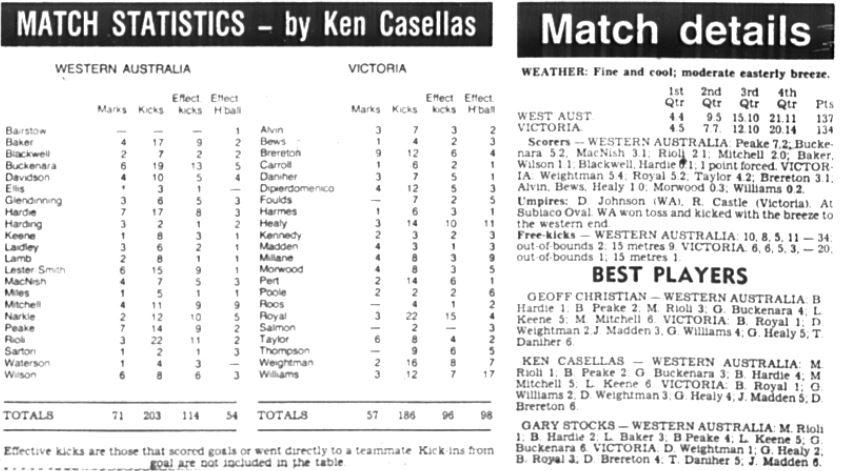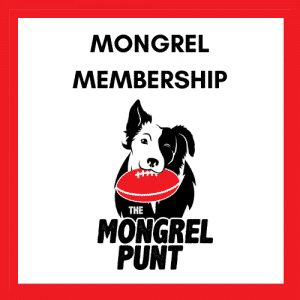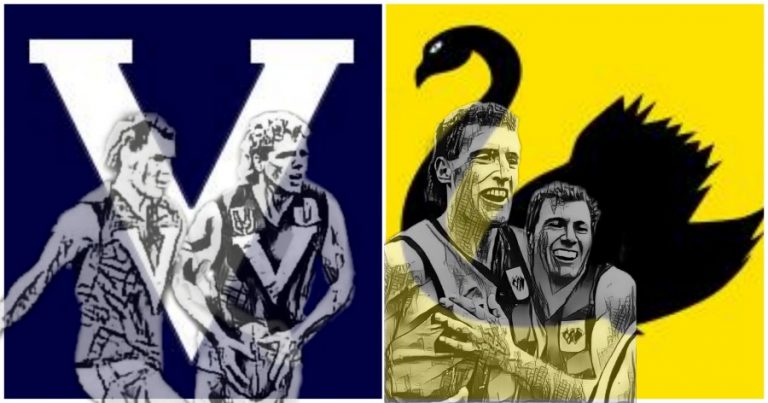With the AFL looking to revive the State-Of-Origin concept as part of Gather Round, albeit in a very different format, it compelled me to start looking back at a period where these games really meant something.
When fans of football discuss the greatest games ever played, there is one that tends to fly under the radar. It’s not really given its due as a great game, and given it was not part of the official season, it is often forgotten by those who have the loudest voices.
Let’s take a small step to rectify that and see what we come up with.
1n 1986, we were still a year away from the VFL becoming something akin to what we know today as the AFL. Within 12 months, the league would house two new teams – the Brisbane Bears, who would struggle through the first years of their existence, and the West Coast Eagles, who hit the ground running and immediately establish themselves as a power in the competition.
Three seasons later, the league would officially change their name from the Victorian Football League to the Australian Football League, and the rest, as they say in the classics, is history.
The State of Origin concept lost a lot of its lustre once we commenced seeing teams representing an entire state on a weekly basis. West Coast were the WA team. Sydney were the NSW team. Ditto Brisbane in Queensland. And soon enough, Adelaide would become the pride of South Australian. Prior to that, however, State of Origin Football was considered the pinnacle of the game – the best players coming together to provide a showcase of the best the game had to offer.
And in 1986, we had a living, breathing advertisement for that concept, as the Victorians made their way over to Subiaco to take on the west of Western Australia in a brilliant game of footy.
To add to the game, or my enjoyment and understanding of the impact of players, I have taken to adding some modern stats to the already difficult-to-find official statistics for the game. My hope is that this can shed a bit of light on the roles occupied by the particular players highlighted.
Shall we get stuck in?
Yes, we shall.
A BRIEF OVERVIEW
This one simmered and bubbled for three quarters, with the home team always seeming to have the answers, sitting anywhere between two and four goals up at various stages.
In the words of the immortal Lou Richards “The Vics will come”… and they did.
What was a highly-entertaining, free-flowing brand of football set up for a brilliant last quarter of footy, as Victoria charged back to claim the lead, which would switch back and forth a further six times. Gary Buckenara, Maurice Rioli, Phil Narkle, and Laurie Keene rallied the WA team and with hard run and desperation, they managed to claw the lead back before a desperate effort from Wayne Blackwell ensured WA would reign supreme.
THE STARS OF THE SHOW
LAURIE KEENE
When I saw that this matchup was Keene against Justin Madden, my initial thoughts were that Madden should have the upper hand.
I guess that comes down to familiarity, as the result was quite the opposite, with Keene clearly controlling the game from the middle and making Madden work around the ground. Serves me right.
Whilst Keene made a couple of silly errors, his impact at stoppages and around the ground was undeniable. He was so effective that it made me raise my eyebrows when WA coach, Ron Alexander, who I remember from his Fitzroy days, dragged him after an error in the third quarter. Perhaps it was just for a rest, but Keane was giving Madden fits, and easily handled Paul Salmon when the two were matched up, as well.
This was probably close to Keene at the tail end of his peak, as by the time West Coast came into the league the following season, he was just starting to fall away. This performance earned him an All-Australian selection.
MAURICE RIOLI
Smooth, silky, and classy. He just looked a cut above when he gathered the footy, and though the game is very different now, seeing the way Rioli moved, and his ability to both find space and punish the opposition with the footy, you just know that he would be highly capable of playing in any era.
By watching these games, you garner a greater appreciation for those who came before, and with Rioli, you’d almost have to be blind not to recognise the special talent he possesses. He made something happen every time he touched the footy.
DALE WEIGHTMAN
Is there an argument that Weightman is the best state player Victoria has had?
His record is exceptional – 20 games for the Big V, two EJ Whitten Medals, and a Tassie Medal, Weightman was just about first-picked every time there was a SOO contest.
He was brilliant again in this one, combining with the next bloke to kick ten goals, How ridiculous is that – to get five goals from each of your small forwards?
H was actually really good in the air in this one, as well, as he worked up through the middle and ran back hard inside 50.
BRIAN ROYAL
Probably the best player for the Vics. Consistently had his head over the footy, found space in the forward line, and managed to be quite creative with the footy when he gathered around half-forward.
One of the more underrated players of his generation, this game was a showcase of just how good he was.
BRAD HARDIE
Killed it. Absolutely killed it all game, floating around half-back to cut the Vics off at the knees all game.
He finished with ten intercept possessions, including four intercept marks, as he consistently put himself in the right spots to repel.
One of his feigns at half-back sold all sorts of candy to his opponent, allowing him to stroll away so easily, I am surprised he didn’t have a bit of a chuckle as he did. One of the more gifted, natural footballers we’ve seen – right up there with Darren Jarman. I wish Hardie had a huge work ethic. Imagine how great he could have been?
DERMOTT BRERETON
I keep a stat for the modern game called the “Get out of Jail” mark, which is when a team targets a player as the only long option and he either outmuscles an opponent, or flies in to take a difficult mark to relieve the pressure on the side exiting defence.
During the 2022 season, the highest I recorded was four, shared by several players. Dermott had five in this game, giving Ross Glendinning the run around early, and then doing the same in the last quarter to Rod Lester Smith.
At this point, Derm was just 21 years old and was just starting to discover the swagger that would make him one of the biggest names in the game. With five contested grabs to lead all players, a performance like this would have given him a heap of confidence.
As though he needed it, right?
GARY BUCKENARA
He was the matchwinner, for me. I loved what Keane did, and I know Brian Peake snagged seven goals, but Buckenara broke the game open.
I’ll go into his early matchup against Dennis Carrol a bit later, but in the second half, Buckenara was everywhere. He moved through the centre of the ground, remained dangerous inside 50, and was integral in just about every WA scoring opportunity. It made me a bit disappointed I didn’t record score involvements, as I reckon he would have easily been in double figures.
Gary Pert was given the job on him following the injury to Carrol, however, the fleet-footed Buckenara found it too easy to lose the defender with a quick trip into the middle of the ground.
I reckon this was a problem with SOO defences, as they didn’t quite work as a well-oiled machine, switching and changing without thinking about it. When Bucky moved into the middle, Pert would go to someone else and then as Buckenara drifted forward, Pert would remain with his current opponent.
Maybe Ron Alexander needs a nod of appreciation for pulling that move?
BRIAN PEAKE
With five minutes expired in the second quarter, former Geelong player, Brian Peake, had five snags to his name, giving Western Bulldog, Rick Kennedy a complete bath.
Kevin Sheedy had stuck with Kennedy on Peake, who just looked to read the ball much better off the boot than his opponent, but the injury to Dennis Carrol forced him to make switches, and Peake ended up with Vic captain, Terry Daniher for company from around halftime, which saw him have a much quieter second half.h
THE MATCHUPS THAT MATTERED
DENNIS CARROLL V GARY BUCKENARA
Perhaps the most important matchup of the day, as when Carroll left the ground due to injury, Buckenara was able to open up. He moved through the middle and collected five clearances in the second half, as well as adding five goals to his name.
Carrol was close to best on ground when he was injured, providing Victoria with five first-half intercepts amongst his ten touches.
MAURICE RIOLI V GREG WILLIAMS
Though they did not play directly on each other, these two were the constants in the midfield as others cycled through.
Williams was doing what he does best, collecting clearances and leading the game with nine, whilst Rioli was able to work to the outside and really punished the Vics whenever they permitted him space.
For those unfamiliar with how Rioli moved, he was sublime at points in this encounter, getting to the right spots, changing direction, and setting up his teammates, whilst adding a couple of goals to his name.
Williams seemed to enjoy using the 15m penalty to his advantage, often electing to hold up the play, give up the small penalty, and slow the game down to allow his teammates to get back in defence. When you watch this game, you can see why the AFL changed this to a larger penalty.
PHIL NARKLE V ROBERT DIPIERDOMENICO
This was a clash of styles on the wing, with the fleet-footed Narkle getting the better of the Hawthorn strongman, particularly as the game wore on.
The Vics failed to capitalise on the size advantage of Dipper, with Narkle winning the footrace whenever the ball hit the deck, and as the contest progressed, it was Narkle providing the overlap run down the wing and delivering the footy inside 50.
Watching this unfold, I was wondering why Kevin Sheedy didn’t make a move to give the Vics some evenness on the outside, but he persisted with the matchup, and the result saw Narkle as a very valuable contributor in the last quarter.
Interesting to see Dipper pull out of a contest on the wing in this one, as well. Not something you’d usually associate with him.
UNSUNG HEROES
ROD LESTER-SMITH
This was a strange selection, as he was playing on Dermott Brereton when the Hawthorn star opened up in the last quarter, but prior to that, RLS put together a fine defensive game.
He took six intercept marks as part of his seven overall intercept possessions, and added seven spoils to his totals as well. It would be easy to look at the last 15 or so minutes and claim he was beaten, but that would be vastly unfair, as he had to pick up the slack for Ross Glendinning, who was being beaten to the footy quite often by Brereton in the first half.
WAYNE BLACKWELL
The Vics had a chance to steal the win with seconds remaining, as Brian Royal found himself out in the open with the goals in sight. It would have been his sixth goal of the game, but a desperate lunging smother from Wayne Blackwell caused a stoppage and from there, the WA team were able to clear and hold on.
As mentioned above, the game was free-flowing, but in the last five minutes, the pressure level went right up and the tackling and attack on the footy were incredible. We could pick out a dozen little actions that made a huge difference, but none of them could top the effort of Blackwell to save the game.
SOME QUICKIES
After watching this one, I will always have a bit of a smile when I hear Gerard Healy complain about poor foot skills. He completely missed teammates by foot on two relatively easy short passes that could have led to scoring opportunities. Glass houses…
Healy did work hard in the middle in the second half, finishing with six clearances for the game.
Really enjoyed the work of Brian Taylor, though I reckon fitness had a big impact on his performance after halftime. BT had five contested marks, using his body perfectly on a couple of occasions in the first half.
Michael Mitchell was an absolute livewire for WA, and received AA honours largely due to his role in this game. His speed and change of direction combined beautifully with Narkle and runners like Leon Baker and Wayne Blackwell as the WA team sliced through the middle of the ground.
It was another shrewd move from Ron Alexander, to send Glendinning to him after about the first quarter and a half. Able to match strength with the volatile forward, the 1982 Brownlow Medallist was able to keep BT under wraps for most of the second half. Maybe he was a pretty good coach, eh?
So good to hear Dennis Cometti on commentary. Damn, I miss him. I loved that he had to correct Lou Richards when he called Wayne Blackwell “Robert Wiley”. Dennis mentioned that they’d changed numbers, trying to save face for Lou, hoping he’d move on. Nup – Lou then asked what number Wiley was wearing.
Resigned to losing this battle, Dennis commented “He’s not playing, Lou.”
Not a bad outing from Darren Millane, but he was yet to morph into the raging bull of a player that would become such a part of the 1990 Collingwood premiership. In this one, he was more like the baby bull. Had five clearances, but most of them would not be called clean footy. He also had three contested marks.
Very disappointing day at the office for Paul Salmon, who was hardly sighted and played a little bit too timidly for my liking.
WRAP UP
I recapped the 1985 Elimination Final yesterday. I feel that this one, though regarded as a great game, was a notch below it. The last quarter was electric, and the situation made for a tremendous last five minutes, but the overall spectacle of the game was perhaps a bit lacking.
It was highly pressured contest at stoppages, with very few clean extractions making it seem messy, but when bodies are flying in from everywhere, as they were in this one, you cut everyone some slack.
Was it the greatest State of Origin game of all time?
Hmmmm, it was entertaining, and the finish was wonderful, but I have a few of these games to get through this off-season. How about I let you know when I am able to review a couple of the close SA v Vic games in the coming weeks?
Again, as mentioned in the 85 Elimination Final Time Machine journey, if there is a game you’d like me to cover from the annals (not a misspelling) of footy history, by all means, let me know.
Also, those with good memories would remember me posting this article before. Nice work – I’m using it as the start of a few State of Origin reviews – some really underrated games amongst them.



